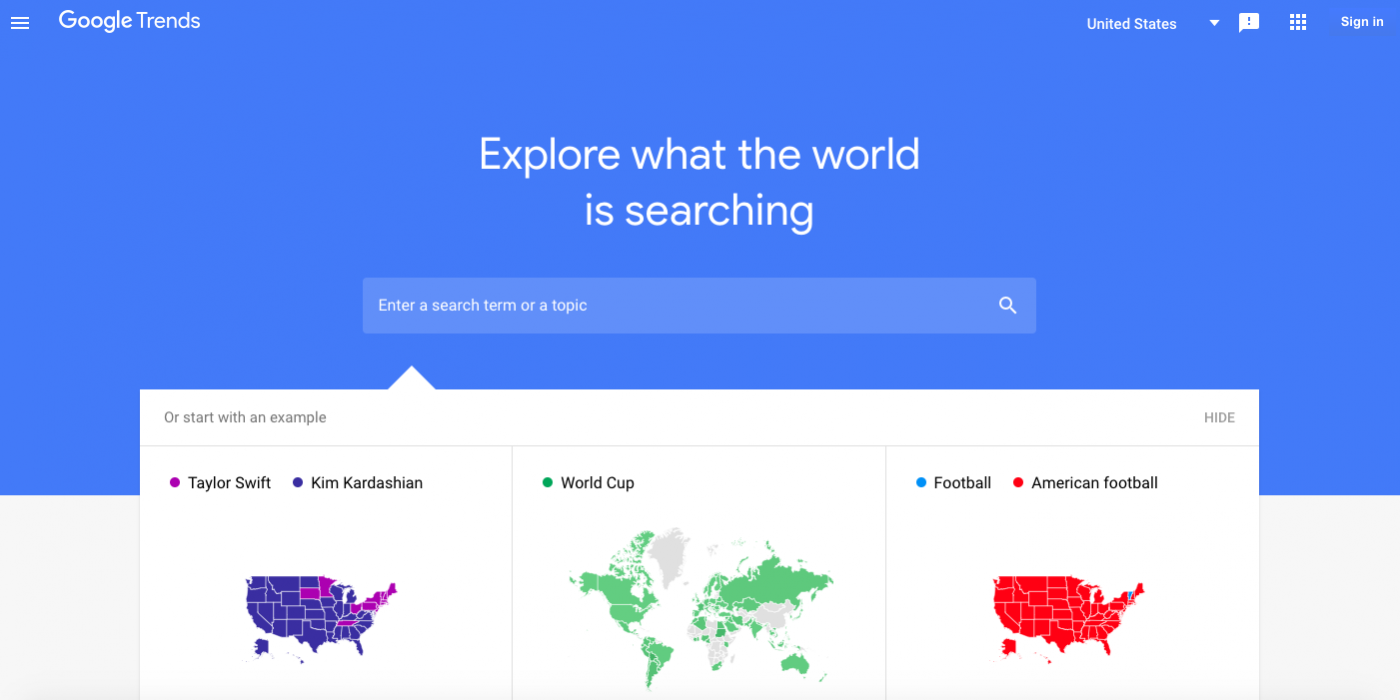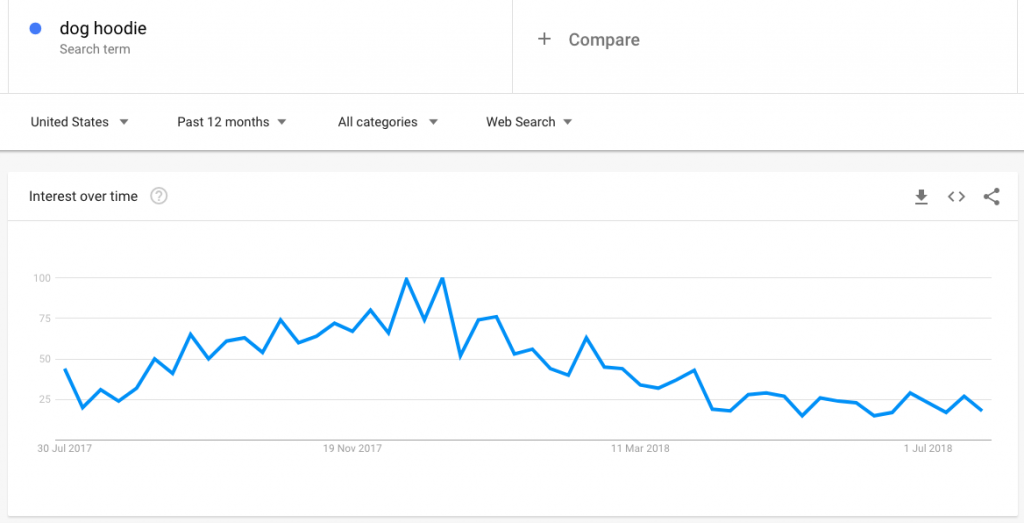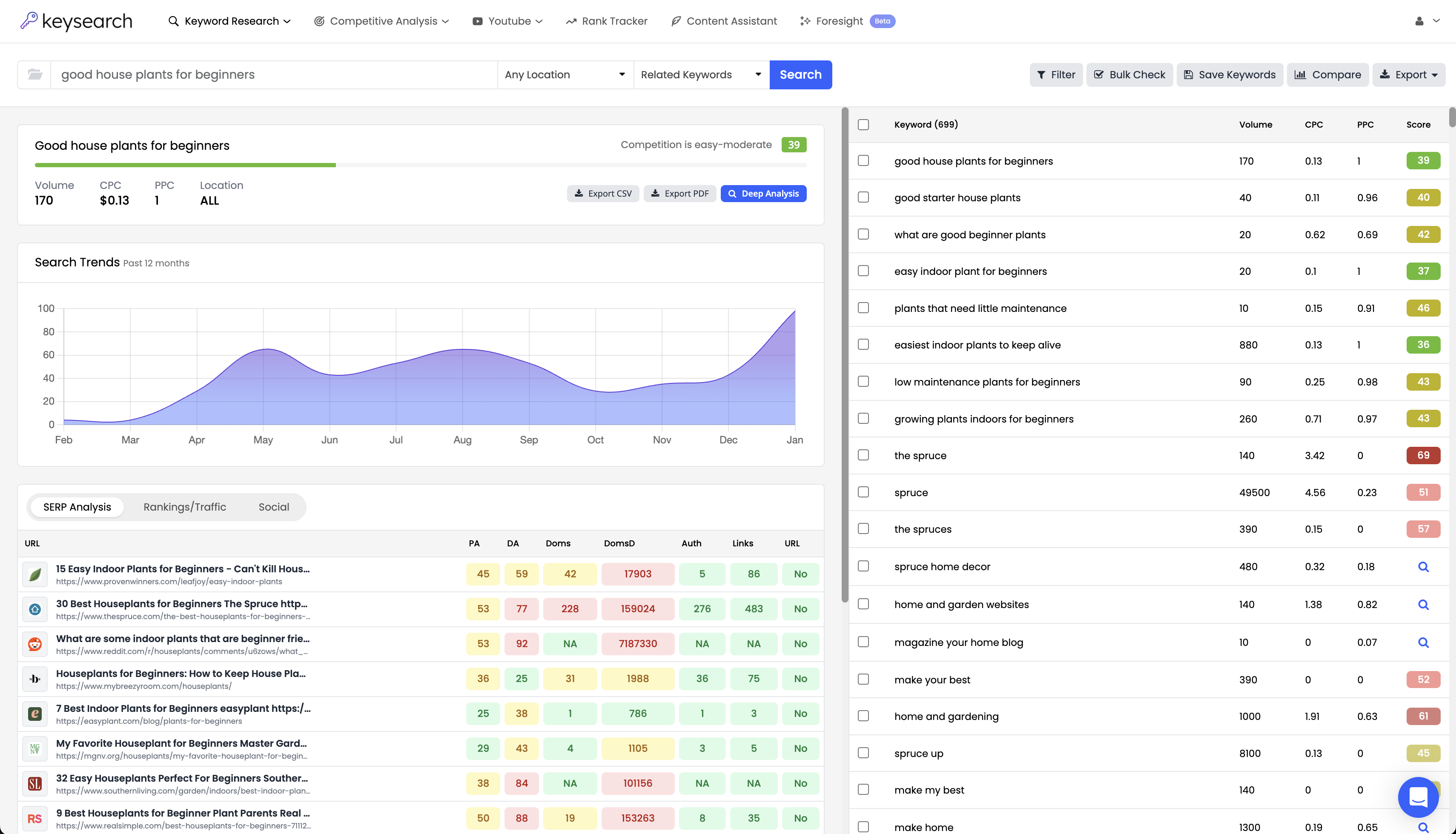Keyword research tools can come in all shapes and sizes. I’m sure you’ve probably noticed though that most tools follow essentially the same idea. They help you identify keywords that will bring in traffic by showing you niche-specific keyword suggestions (search volume usually included). Then they will give you an estimate of how difficult it will be for your site to rank in a top position for those keywords.
This is a simplified explanation of what Keysearch does as well as pretty much any other keyword tool you may find. Personally, I love this approach as I’m sure you do too. It’s worked for me for a long time and continues to be the backbone of my keyword research process.
What typical tools might miss though is the ability to easily identify trending keywords. These trending keywords can hold a treasure trove of value, especially in certain niches. Luckily there is one tool though that is completely free, and when combined with your other keyword research methods can uncover great trending keywords and topics you might not have found otherwise.
Google Trends and Keyword Research
Google Trends can reveal hot topics for which the search results are not yet dominated by authoritative websites or where the search engines are looking for fresh relevant content. The idea here is if you act quickly and publish great content before the competition, you can get a jumpstart on a keyword or topic that the rest of your niche may not have found or properly optimized for quite yet.
Now you may have noticed in Keysearch that we show a “Search Trends” graph for every keyword. This graph is taken directly from Google Trends and shows you how popular the keyword was at specific times over the past year.
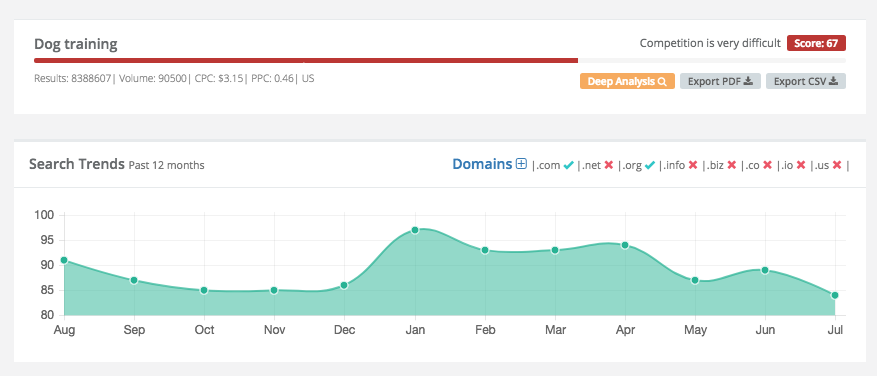
We prefer to show the Google Trends data graph rather than the AdWords (Keyword Planner) search volume trends for a few reasons.
- Google has started grouping keywords into “close variants” and the search volumes are less and less accurate every day (this is something Keysearch is starting to address and you can read about it here).
- Google uses search volume “buckets”. This basically rounds the search volume to the closest bucket. For example, the Google search volume for the keyword “dog training” is 90,500 in the United States. 90,500 is one of their search volume “buckets”. These buckets are fine for an overall idea of search volume but when looking to see the trending search volume it can sometimes mask what’s going on. The next closest search volume buckets are 74,000 and 110,000. We find that Google Trends shows a much better and granular idea of what is actually going on with search trends over the past year.
- Having a data overview from more than one place is usually always advantageous.
As you can see we are fans of Google Trends and even utilize it in our own tools. We thought it would be good to show you what Google trends can offer, how to use it, and an overview of how you might incorporate it into your own keyword research campaigns.
How to Use Google Trends
First of all, go to Google Trends. You’ll land on a page that looks like this:
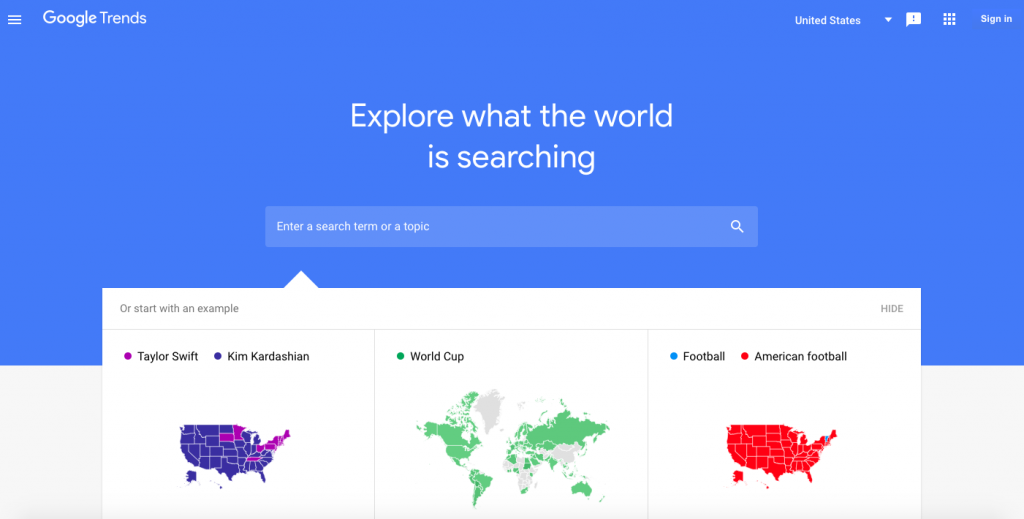
You can see a couple of trending topics but in most cases, they will be irrelevant to your nice. The most popular searches often revolve around sports, news, celebrities, or politics.
Note that you can search the trends for any country you want by clicking the arrow next to “United States” at the top-right corner of the page and selecting whichever country you’re targeting.
Now, the search bar at the center of the page is where you type the search term.
For this tutorial, let’s say I have a dog training business. I’ll simply type “dog training” in the search bar and press Enter.

Now let’s see what Google has to say about this keyword.
Interest Over Time
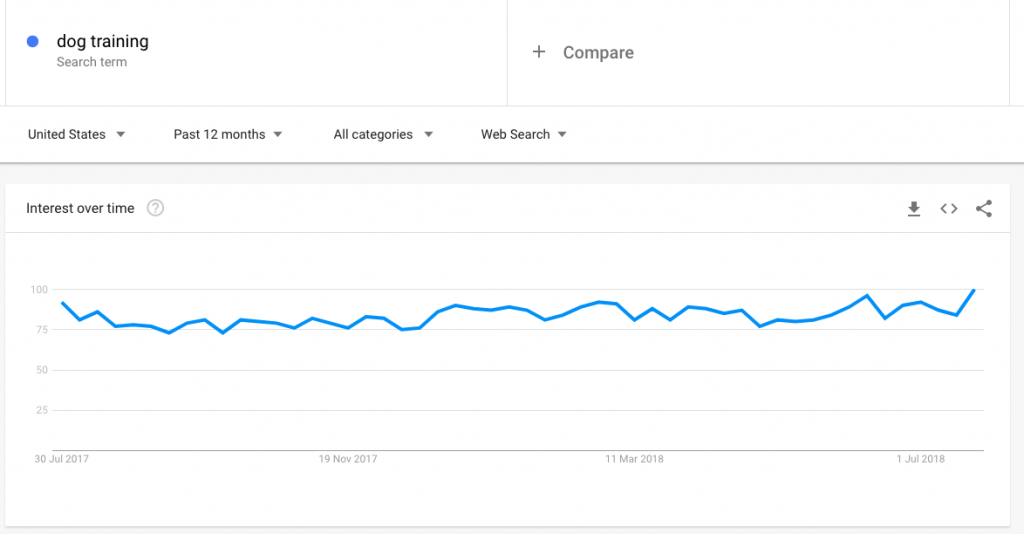
The first thing you’ll notice is this graph titled “Interest over time”. For the past twelve months, the curve oscillates between 80 and 100, but what does that mean?
These numbers may be confusing at first, but they really are simple to understand. These values are called Trends data, they go from 0 to 100 and indicate the search interest on a given topic as a proportion of all searches on all topics in a given place and time. So it is the relative popularity of the keyword compared to every search done on Google. The higher the value is, the more trending a topic is, with 100 being the maximum value.
In our case, dog training seems to be a highly popular topic, seeing how it stays consistently above 80. This is because about 68% of US households own pets, a big part of which are dogs.
Compare Multiple Search Terms
With Google Trends, you can also compare the popularity of two or more search terms to see how well they fare against each other and pick the more promising ones.
To do that, go back to the top of the page, click on “Compare”, and type the second keyword. I’ll go with “dog grooming”.
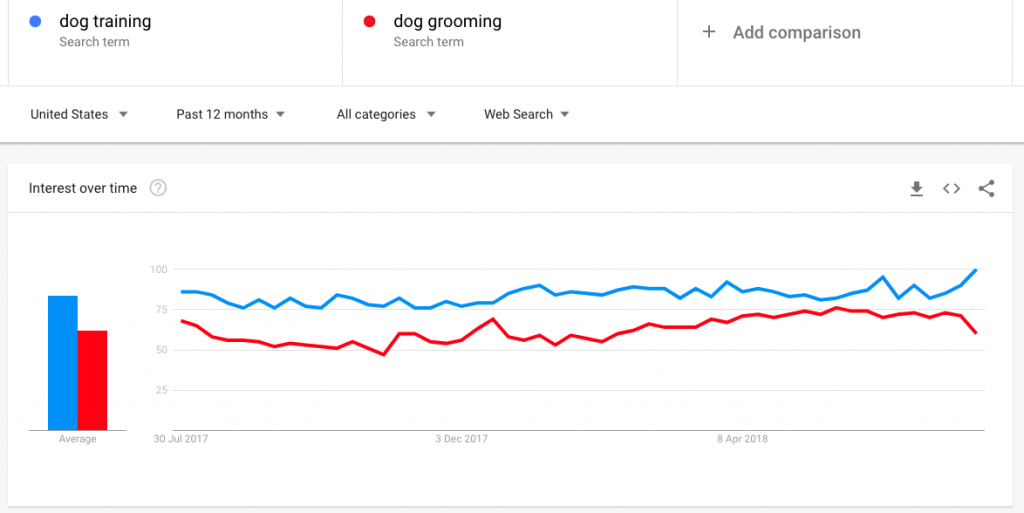
While dog grooming is not far below dog training, it seems to be on a slight downward trend, so it’s probably not the best pick for content scheduled to be published in the short term.
Refining Your Search
You have probably noticed the four drop-down menus right above the graph. You can use these to refine your research with specific criteria:
– Country: as with the previous page, you can change the country of choice to your liking. You can also choose “Worldwide” to get global results.
– Timeframe: you can inspect data from the past hour, four hours, day, week, month, three months, a year, or even the past five years. You can also customize the time range as you want and even go back in time until 2004.
– Categories: you can restrict the search area to certain topics like arts & entertainment, beauty & fitness, news, science, travel… or you can simply click “all categories” if you want to stay broad.
– Type of search: you can select between web search, image search, news search, google shopping, and YouTube search. You can’t really go wrong with picking all types, though.
Now let’s see what else Google Trends has to offer.
Interest by Region or Sub-Region
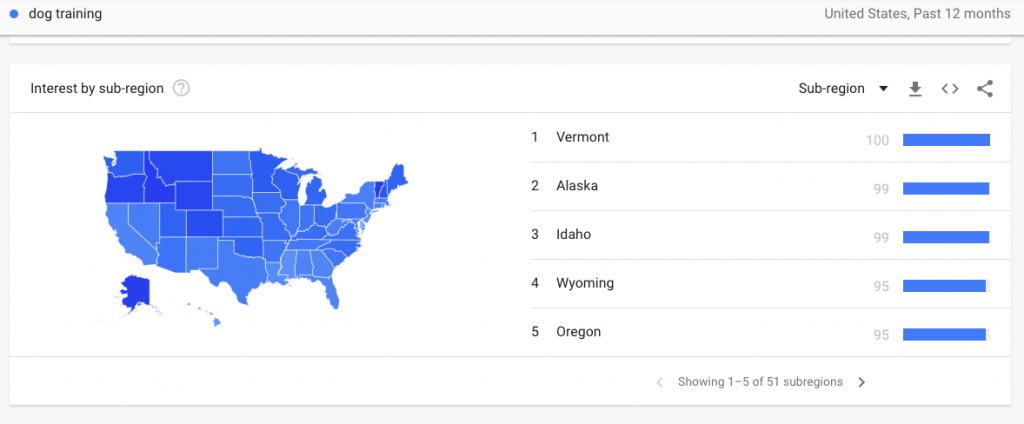
By scrolling down the page, we find this box. As you can see, it breaks down the search interest by sub-region which is great for local SEO. The states with the darkest shades of blue (Vermont, Alaska, etc.) have the highest Trends data, so dog training is most trending there.
Knowing which sub-regions (or regions, if you went for a worldwide search) have the most interest helps you be more efficient with your content marketing by focusing more on those with the highest interest. This can also help you focus your content locally if that’s something your niche can cater to.
Related topics and related queries
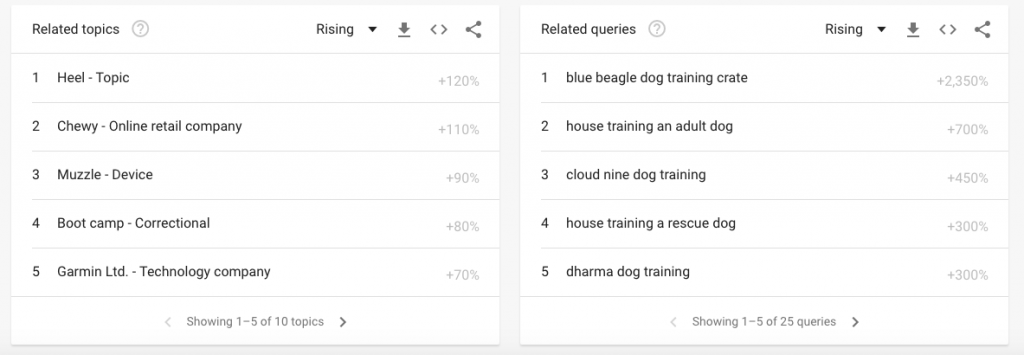
Scroll down the page again and you’ll find these two boxes. The “Related Topics” box shows topics that people are also searching for.
The really interesting part is the “Related queries” box on the right, which reveals related keywords that are most used for a given topic. In other words, these are trending keywords.
And if you haven’t noticed, they totally look like long-tail keywords – the sweet spot in keyword research.
Cloud Nine Dog Training and Dharma Dog Training seem to be popular competitors, so they are probably doing something right with their marketing. I could do a little spying on them and see what kind of content I can use for my own business.
The percentages next to the queries represent the growth in searches over time. In the last twelve months, interest in the query “blue beagle dog training crate” has grown by 23.5 times, which is very impressive. Similarly, searches for “house training an adult dog” have multiplied by seven times.
You can filter topics and queries by “Rising” or “Top”. “Rising” shows the growth in interest in percentages, while “Top” gives a score up to 100. Depending on which you pick, the results shown may be a little different. If you see “Breakout” instead of a percentage, it means the search term has grown by over 5000%.
With a little bit of imagination, and by checking the rest of the queries, now I can quickly come up with headlines for blog posts, topic ideas, free reports, or any kind of content:
- 5 Tips for Blue Beagle Crate Training
- How to Solve Common Problems when House Training an Adult Dog
- Essentials of Service Dog Training
- What Does the Law Say About Service Dogs?
- How to Succeed in Training an Aggressive Dog
Note that you can download the search terms in Excel sheets. They also might change the next time you use Google Trends, as the data is constantly updated.
Mining For Upward Trends
We also don’t have to stop there. Our goal with Google Trends is to find target keywords that are not only trending upwards but maybe “hot” at a specific time. Capitalizing on the latest search trends and being able to identify seasonal trends is a huge advantage!
In my dog training niche, we can throw around some seasonal keyword ideas, like “dog hoodie”. I would think this might be trending during a certain period of the year (winter). From the graph below I was right! There is a definite spike in popularity during the winter months.
While these seasonal peaks should not be the bread and butter of my content strategy, with the right timing I can still leverage them to create content that attracts traffic.
Next year, right around December – January I might want to create some content on the top 10 dog hoodies of 2019. I could even touch up old content on the topic each year, making it fresh for Google just at the perfect time. Google loves fresh relevant content, especially on trending topics.
Finding Trending Keywords: Final Thoughts
Using Google Trends to find trending keywords allows you to bypass timeless topics where competitors have already established their authority, to focus more on new and popular topics. It is a great source for generating content ideas, social media posts & video topics that can help you poke through a competitive niche.
With that said, it is just one tool in your arsenal though. You still want to make sure you are targeting topics that will drive traffic. Also keep in mind that just because a topic is trending doesn’t mean the rest of your niche is clueless about it. You still may to do some link building, content marketing, etc…
Do your due diligence and make sure that putting the time and effort into creating new content or touching up old content is worth the investment. This is where those good ol’ keyword research tools come in handy. So start brainstorming and take advantage of the traffic that trending keywords can offer!
- How to Do Keyword Research for Free: Best Free Keyword Research Tools in 2024 - December 13, 2024
- Benefits of Keyword Clustering: Why is it Important to Group Relevant Keywords Together? - December 13, 2024
- What is Keyword Density in SEO and Its Importance - December 13, 2024

